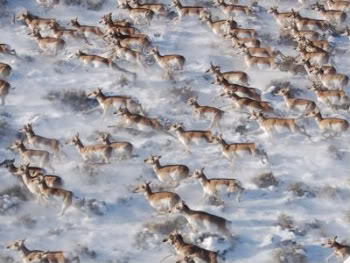|
|
Watch any nature documentary and it’s sure to include pulse-pounding footage of large herbivores migrating across African plains, Asian steppe, or the Arctic tundra. The images have become iconic: wildebeest forging a crocodile-inhabited river, caribou breaking through snow fields, Saiga running over tall grass. Despite such images of plenty, migrations are declining across the world, and in six cases have disappeared entirely.
A new study published in Endangered Species Research looked at the state of just these kinds of migrations, focusing on 24 large ungulate species (hoofed animals) known for their migratory patterns. Researchers included some well-known species, such as caribou, American bison, elk, zebra, wildebeest, chiru (or Tibetan antelope), and saiga.
“Conservation science has done a poor job in understanding how migrations work, and as a result many migrations have gone extinct,” explains Grant Harris of the Center for Biodiversity and Conservation at the American Museum of Natural History, first author of the paper. “Fencing, for example, blocks migratory routes and reduces migrant’s access to forage and water. Migrations can then stop, or be shortened, and animal numbers plummet.”
 Pronghorn antelope migration. Photo by: J. Berger. |
According to the study, all 24 focal species lost migration routes and suffered population declines. Many of these migrations have been little studied. While Africa includes the most large-scale migrations, the authors found that three migrating species had no publications on their population status. In Eurasia half of the migratory species had been largely ignored by science.
Six of the focal species either no longer migrated at all or, in a couple cases, no longer survived in the wild: the springbok (Antidorcas marsupialis) used to form some of the world’s largest migrations; the black wildebeest (Connochaetes gnou) was nearly exterminated and has relied on reintroduction efforts; the blesbok (Damaliscus dorcas) is not endangered but no longer migrates; the dwindling kulan (Equus hemionus) of central Asia; the scimitar horned oryx (Oryx dammah) is extinct in the wild, but there are plans for reintroduction; and the extinct quagga (Equus quagga) from southern Africa.
Such migrations have declined—and disappeared—due to fencing, land-use changes, water restrictions, and unsustainable hunting practices. Preserving migrations, however, has proven more difficult than identifying the causes in their decline.
“If we are going to conserve migrations and species, we need to identify what needs to be done: where migrations remain, how far animals move, their habitat needs and location, threats, and the knowledge gaps needed to be filled,” says co-author Joel Berger of the Wildlife Conservation Society and the University of Montana. “For some of these species, such as the wildebeest and eland in Botswana, threats were identified decades ago. We as a society have made little progress at figuring out how to save migrations.”
Of course, declines in migrations don’t just affect the migrants. Predator numbers decline as their food sources dry up, and plant biodiversity changes when thousands of herbivorous mammals fail to show up.
Harris adds that “a large part of this is an awareness issue. People don’t realize what we have and are losing. We lose migrations and become biologically depauperate with farms and fences, even though there is no reason why humanity cannot technically and socially advance while maintaining natural phenomena. A balance can be struck—we just need to strike it.”
Related articles
The end of migrations: wildlife’s greatest spectacle is critically endangered
(07/28/2008) If we could turn back the clock about 200 years, one could watch as millions of whales swam along their migration routes. Around 150 years ago, one could witness bison filling the vast America prairie or a billion passenger pigeons blotting out the sky for days. Only a few decades back and a million saiga antelope could be seen crossing the plains of Asia.